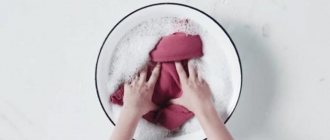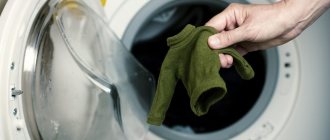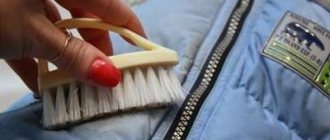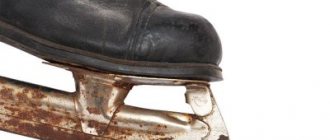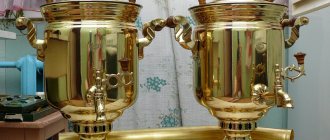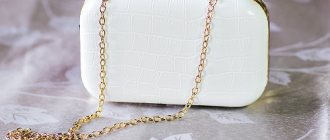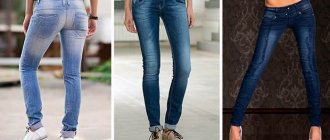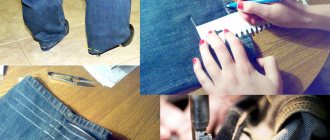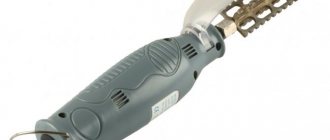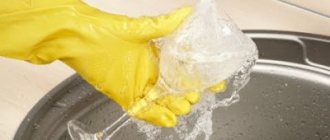Removing stains is a pressing problem for most women. Even the most careful person can stain his favorite sweater or shirt by accidentally spilling coffee on it. To remove contaminants, you can use available products that are in your kitchen or in your home medicine cabinet. They can also be purchased at any hardware store or pharmacy at a relatively low price.
If you still decide to remove the stain without taking the item to the dry cleaner, then use the useful tips presented in our article. It contains the most popular questions related to effective methods for eliminating traces of various types:
- Rules to follow when removing contaminants
- Removing grease stains
- How and with what to remove ink marks from different pens?
- Removing berry and red wine stains
- How to remove stains from white wine?
- How to eliminate the formation of rust on things?
- Removing stains from coffee, chocolate, cocoa and tea
- Removing milk stains
- How and with what to remove blood stains?
- Removing stains from other clothing
Rules to follow when removing contaminants
Before removing any formations on your own, you should familiarize yourself with the following tissue care rules:
- Dirt from thin fabrics is cleaned from the inside out;
- if the use of a certain stain remover can provoke a change in the color of a colored item, then it should be tested in an inconspicuous place;
- Don’t put off stain removal until later. This situation allows microelements to penetrate deeper into the tissue structure, which over time complicates their removal;
- Removing stains should begin with finding out the nature of the contamination on things. This can be done by appearance, color, smell or other characteristics;
- if you were unable to find out the nature of the origin of the stain, then first you should try more gentle products or universal stain removers;
- It is important to pay attention to the manufacturer’s recommendations for fabric care, which are indicated on the product label. The label contains instructions on how to wash, dry and iron the item, whether the material is suitable for dry cleaning or whether it is contraindicated;
- After removing the stain, the product must be rinsed with water or washed with washing powder.
- If the item cannot be washed, then the remaining stain remover is washed off by applying a cotton swab moistened with clean water.
Treatment of fabric with various solvents is called “dry cleaning,” that is, stains are removed without first soaking the item. Solvents are harmful, volatile and flammable substances. In dry cleaners, the use and storage of such materials takes place in special workshops that comply with technical safety standards. When using such solvents at home, you need to remember that:
- the use of such substances may harm the skin. Therefore, it is necessary to work with them with gloves, and after use you need to lubricate your hands with cream;
- cleaning should be carried out away from open fire and heating devices;
- Removal of contamination should be carried out in a well-ventilated area, since inhalation of large amounts of vapors of harmful substances can cause headaches and nausea.
Special products for removing greasy stains from household chemicals
Oily stains can be removed with products containing enzymes, active oxygen, and surfactants.
Household chemicals are used according to the instructions on the label.
The best stain removers:
- Dr powder Beckmann Oxy Magic Plus;
- dry bleach Clean Home Express effect;
- liquid Vanish Gold Oxi Action Pink;
- Pip aerosol with cleaning probiotics.
There are features for removing stains. Vanish is rubbed over their surface or Pip is sprayed or a paste is applied (powders are mixed with water). Then wait a while and remove from clothing according to the conditions on the product label.
Removing grease stains
Fats tend to oxidize, so they quickly permeate the material and become attached to it. That's why you shouldn't put off the cleaning process for a long time. Fresh stains are removed quite easily compared to old ones. It is necessary to iron the oily contamination with a hot iron through disposable paper towels, which are placed on top and bottom of the fabric, and during the ironing process they are replaced as they become soiled.
To remove stubborn grease stains, gasoline (gasoline for refilling lighters), turpentine or other solvents are usually used. When cleaning, it is recommended to place several layers of paper napkins, cotton wool or any absorbent material under the stained area. Rub the stain from the edges to the middle so that it does not spread. After removing it, wash the item in warm water. Fabrics that cannot be washed should be dried and ironed.
Ammonia (10% ammonia) is considered an affordable and effective means for cleaning grease stains. With it, removing stains from fabrics is not such an insurmountable task. For colored items, it is recommended to test in an inconspicuous place, as the substance can change the original color of the textile.
Let's consider several options for cleaning things stained with grease:
- You need to mix 1 tablespoon of ammonia and 1 teaspoon of table salt. Apply the resulting mixture to the stained area, rub, and then rinse with water.
- Mix 1 tablespoon of turpentine with 10 ml of ammonia. Apply the resulting solution with a cotton pad to the stained area. Then rinse with warm water.
- To obtain the product, mix 10 ml of alcohol, ½ teaspoon of citric acid, 1 teaspoon of table salt and 200 ml of water. Treat the contaminated area with the prepared solution and rinse with warm water.
- Take dishwashing gel and apply it to the stain. Leave the item for 10–15 minutes, then rinse in warm water.
- For velvet fabrics, you need to take a little bread crumb, apply it to the oily formation and give it time to absorb. Repeat the procedure several times. Then wash the clothes with soap.
- For colored cotton fabric, use a paste made from mustard powder and water. It is smeared onto the fatty mark and left to dry for half an hour. After which the paste is removed from the surface and the item is washed.
Causes of traces of fat
Synthetics, textiles or other porous materials get dirty when in contact with a greasy product.
What causes spots to appear:
- from oil (butter, vegetable, essential, machine, massage);
- creams, face masks, other cosmetics;
- confectionery sweets;
- lard, lamb or other fat;
- medicinal products containing oils, esters, fats;
- other fatty foods and products.
More often, fatty substances get on clothes during food or cooking. Often the fabric becomes soaked from the body after treating the skin and becomes dirty from touching a dirty surface or hands.
How and with what to remove ink marks from different pens?
Removing ink stains from ballpoint and gel pens can be done using any of the methods given below:
- Dilute acetic acid in hot water in a ratio of 2:1. Using a cotton swab, wipe the stain with the prepared solution, then rinse with water.
- Mix 2 teaspoons of hydrogen peroxide (3%) with 200 ml of water. Wipe the stained area with a moistened cotton pad. This method is only suitable for white materials, since hydrogen peroxide is a good bleach by nature.
- Soak a cotton pad in ammonia and rub the contaminated area with it, then rinse the product in water.
- Dissolve 2 teaspoons of baking soda in 200 ml of hot water. Soak a cotton pad in the resulting solution and rub the stained area.
- Fresh ink marks can be easily removed with lemon juice or a 10% citric acid solution. After removing the stain, the item should be rinsed in water.
We remove various stains
When fruit juice or fruit pulp gets on your clothes, treat the surface with lemon juice mixed with salt (citric acid will also work). We wash off the ingrained juice using hot steam, vinegar or a mixture of lemon juice, denatured alcohol or vodka. The final stage is to dissolve ammonia in water, dip a cotton swab into the resulting mixture and wipe the cleaned area. To remove traces left by wine, take 1 liter of clean water, add ammonia (2 spoons), mix and apply to the stained area. You can get rid of any remaining cleaning composition by blotting with a damp cloth. Use this method to remove painted stains from snow-white clothes.
Sometimes improper washing leads to fatal consequences - unsightly faded marks appear on the surface of a colored product. To restore the brightness and attractiveness of your favorite blouse, you can remove stains with ammonia and hot water. The algorithm for saving things is extremely simple: arm yourself with a large saucepan and pour high-temperature water into it. Pour in a bottle of ammonia and use the resulting solution to soak the damaged item for a quarter of an hour. When the measured time is over, take the product out of the pan and rinse thoroughly. It is better to hold the fabric under the tap - this way the specific smell will disappear faster.
Removing berry and red wine stains
Fresh dirt is covered with finely ground table salt ("Extra"), after a while it is washed off with water, and then the item is washed.
To remove old traces of berries and red wine, the following methods are used:
- Soak a cotton pad in hot milk and rub the stain. After you have managed to remove traces of wine or berries, rinse your clothes in water.
- Add a few drops of ammonia to hydrogen peroxide (3%). Soak a cotton swab in the resulting mixture and rub the stained area. Can only be used for white items.
- Mix glycerin with the yolk of one egg. Wipe the contaminated area with the resulting product and rinse with water. This mixture can be used for colored textiles, since glycerin does not change the original color of things.
- Pre-blot any traces of wine or berries with a dry napkin. Prepare a solution of 10 ml glycerin, 10 ml ammonia and 30 ml vodka. Soak clothes in it, then wash them by hand.
Can you be poisoned by ammonia?
No matter how common ammonium hydroxide is, ammonia is dangerous to human health. People suffering from epilepsy should never snort ammonia. Instead of relieving the condition, this will cause a resumption of seizures. Do not use products with ammonia during exacerbations of skin diseases.
You should not use ammonia-based products on children - it is likely to cause more poisoning than in an adult. Inhalation of ammonia vapor can cause severe poisoning. Ammonia poisoning can be identified by coughing, severe shortness of breath, and a feeling of heaviness in the chest. If you feel a spasm in the larynx and you have been in contact with ammonia, then most likely you are poisoned by ammonia. In severe poisoning, hallucinations and swelling of the respiratory system may occur.
If ammonia vapor gets inside, you can expect diarrhea with blood, a drop in pressure, and pain in all areas of the gastrointestinal tract that ammonia has reached. The victim requires immediate hospitalization.
Undiluted ammonia solution may cause burns if it comes into contact with skin. In this case, this area needs to be rinsed for a long time.
If you feel slightly unwell from contact with ammonia, drink milk, egg white or a boatful of butter.
How to remove stains from white wine?
Removing white wine stains is a fairly simple task if you follow one of the tips below:
- Dilute 20 g of white soap and 10 g of soda ash in 1 liter of water. The item should be washed in the resulting mixture.
- Add 1 teaspoon of hydrogen peroxide 3% to 100 ml of water. Rub a white wine stain with a cotton swab and then rinse the item with water.
- Mix 10 parts by weight of soap, 2 parts by weight of turpentine and 1 part by weight of ammonia. We wet the cotton wool in the mixture, wipe the desired area with the resulting composition, after which the clothes should be rinsed with warm water. This method works well on stubborn white wine stains.
Fabric bleach
Over time, during wear, any white item loses its original color and begins to fade, acquiring a gray tint. Washing machines with the best powders and bleaches may no longer cope with this problem. Quite often such things end up in rags.
However, “grandmother’s” recipes using ammonia will help here too. It is enough to combine one tablespoon with two tablespoons of 3% hydrogen peroxide and pour everything into a bucket of hot (60-70°C) water. First you need to wash the laundry, then pour the prepared solution into it so that it covers the clothes for 20 minutes. Then rinse twice in running water.
How to eliminate the formation of rust on things?
You shouldn’t put off removing rusty deposits from things for too long. They can disrupt the structure of cotton, linen and other textiles. Typically, rust on clothing occurs from metal buckles, buttons, buttons, loops (during washing or drying). If you decide not to dry clean the item, you can try to remove the stain yourself using citric acid or freshly squeezed lemon juice. Let's consider several options for removing rust from things:
- Depending on the degree of contamination, you need to take from 5 g to 20 g of citric acid and dissolve it in 200 ml of hot water. The solution must be heated and the rust-stained area should be dipped into it for a short time, then rinse the area with warm water.
- Moisten the area where the rust has formed with the juice of freshly squeezed lemon, iron it with an iron through gauze, then rub the stain again with a pre-moistened cotton pad, and rinse the clothes with warm water.
If a rusty stain has formed on white leather or suede accessories (bag, gloves, etc.), then it makes sense to immediately take the item to dry cleaning. As practice shows, removing such stains at home rarely gives positive results.
Benefits of Vinegar
- You can safely wash a new item by adding a little vinegar to the water. Then it will remove the aggressive elements used in manufacturing.
- By washing with vinegar, you don't have to worry about hard water stains or laundry detergent stains. It will easily remove both.
- By adding the product to the washing machine, you will ensure not only gentle cleaning of things, but also the safety of the equipment itself.
- Vinegar is sometimes even used as a washing powder mixed with soda. It not only disinfects clothes, but also has a softening effect. Therefore, wearing things washed in it will be much more pleasant.
Removing stains from coffee, chocolate, cocoa and tea
Contamination from such drinks and foods turns a light yellow color on clothing. They penetrate deeply into the structure of the canvas and over time they become increasingly difficult to get rid of. Let's look at several ways to remove stains of this nature:
- Mix 1 tablespoon of hydrogen peroxide 3%, 100 ml of water and a small amount of ammonia. Wipe the stained area with the resulting solution and rinse with water. The mixture removes bright stains on white textiles well.
- We heat the glycerin and dip the stained area of the item into it for a few minutes, then rinse it with water. This method is used for colored linen.
- Dissolve 1 tablespoon of glycerin and 1 teaspoon of ammonia in 100 ml of water. We wipe the stained area with the resulting composition and rinse it with water. The mixture is used for colored textiles.
- Mix 40 ml of ethyl alcohol and 30 ml of 10% ammonia and apply to the dirty mark. Blot the stain with a dry cloth, replacing it with a clean one as it gets dirty. Wash the item using powder or soap.
- Treat the stain with white spirit using a cotton pad. Wash off any remaining solvent with water adding 10 drops of ammonia (10%).
The benefits of ammonia in the household
Ammonia has long been known as a stain remover, especially in areas where work needs to be done without streaking. If you add a few drops of ammonia when cleaning the floor, the smell will make insects leave the house. This technique can be used not only at home, but also outdoors. Spraying an ammonia solution can repel both mosquitoes and midges.
Ammonia is perfect for adding shine to crystal. If you wipe glass surfaces with a drop of ammonia, even stubborn stains will come off.
The unpleasant odor of ammonia tends to disappear quickly due to the high volatility of the substance.
Therefore, no matter how contradictory it may seem, ammonia is an excellent remedy for unpleasant odors in the home. It is worth leaving dishes with ammonia in the room for several days, then thoroughly checking and there is no trace of unpleasant odors.
Removing milk stains
Spilled milk, which has not had time to be absorbed into the structure of the fabric, on white and painted things, can be removed with water with the addition of ammonia (for colored textiles, first test in an inconspicuous place).
Old milk stains can be removed using the following methods:
- Rub the stained area with glycerin using a toothbrush. Let it absorb, then rinse with water and dry a little. Then iron the clothes from the inside out. This method is suitable for colored items.
- Mix 2 parts glycerin, 1 part ammonia and 20 parts water. Moisten the milk stain with the resulting solution. After this, wipe the stained area with a cotton pad, changing the pad as it gets dirty. Dry the area of clothing, then iron it through gauze.
- Combine 1 part ammonia, 20 parts glycerin and 20 parts water. Wipe off the dirt with a cotton pad, then rinse with water. The mixture is used to clean silk products.
- Prepare a solution of lemon juice and turpentine in a 2:1 ratio. Treat the stain on the item, wash with water and laundry soap.
How to remove old greasy dirt at home
Before cleaning, steam the stained area. The area with an old greasy mark is treated with a steam cleaner or held for 10 minutes over the spout of a boiling kettle. Afterwards, clean with a commercial or homemade stain remover.
Working anti-fat agents:
- a mixture of ammonia and glycerin (1:1);
- a mixture of starch with hot milk (mix to a paste);
- stain remover gel concentrate Sodasan Spot Remover (with sponge brush).
It is recommended to treat greasy stains on the front and back of the clothing. A film is placed under it so that the product does not discolor or stain the clean fabric. The stain remover is applied to the problem area, left for 10–20 minutes (starch paste is kept for 6–12 hours) and washed.
See review:
How and with what to remove blood stains?
Fresh blood stains can be easily removed by simply washing the item in cold water. You can change the water 2-3 times. It is contraindicated to soak blood formations in hot water, as the blood tends to “coagulate” in it. For stubborn stains that cannot be removed by regular washing, you can try the following methods:
- Dilute 1 tablespoon of ammonia in 1 liter of water. Wipe the stained area of clothing with a dampened cotton pad. Then wash off the remaining solution with water.
- Prepare a solution of 1 part hydrogen peroxide 3% and 20 parts water. Soak a cotton pad in the resulting product, rub the stained area, then rinse with water.
- Mix potato starch with water to a dough consistency, spread on the stain and wait until it dries completely. Then remove the starch and wash the product.
Removing fat in the oven
All housewives know how difficult it can be to wipe grease off an oven. Ammonia will be a real salvation in this difficult matter.
It is necessary to leave the container with ammonia in it overnight, close the door tightly, and in the morning wipe everything thoroughly with a dry cloth. The dirt will easily come off the walls, and there will be no smell left either. The only inconvenience is fumes, so it is better to work with open windows and wearing rubber gloves.
Tips for removing stains
Before cleaning begins, you should perform a few simple manipulations. The first step is to determine what exactly the clothes are contaminated with. Fat marks have a blurred outline. After contact with the material, the greasy mark is dark, then it acquires a matte tint. Fruit juice, wine and beer leave yellow or brown spots with a dark, clear outline. Often you have to get rid of milky, bloody and oily marks that are yellow or reddish-brown. The color of difficult-to-remove marks left by cosmetics, tea, coffee, mold becomes yellowish, reddish or brown over time.
The first cleaning step: take a brush or damp cloth and get rid of the dirt. We test the selected stain-removing composition (we’ll talk about them in more detail later) in an inconspicuous place: the product should not deform or fade. If you do not resort to a full wash, place the item on a flat, hard surface and place a well-absorbent material underneath. Clean starting from the edges and moving to the center. It is better to start with a weak concentration of cleaning agent and gradually increase it. If the method does not work, rinse the material and try another method.
Grooming
Ammonia (a little) is added during washing to soften the water. When caring for white woolen items, it is necessary to add ammonia.
If wool pellets appear, you need to add 3 tbsp to 10 liters of soap solution. l. ammonia along with 1 tbsp. l. turpentine. The wool is soaked in the solution for a day. Afterwards you need to rinse it in cool water. The method is also effective for getting rid of pills from knitwear.
The collar area of a woolen dress or jacket will be eliminated from grease marks by consistent treatment of the stain:
- cut raw potatoes;
- water;
- with a brush dipped in ammonia;
- with a wet cloth.
After this, the item is washed; when rinsing the laundry, ammonia should be added again.
Getting rid of traces of milk is possible with a mixture of 3 tbsp. ammonia with 3 tbsp. denatured alcohol and 1 tbsp. l. simple table salt applied to the stain. Let everything soak in, then wash the item with laundry detergent.
Stain remover
Heavily soiled laundry can be cleaned with stain remover or ammonia. Things should be soaked in water with ammonia, then washed as usual.
Ammonia (½ tsp) and glycerin (2 tsp) applied to tea, coffee or cocoa marks will remove them completely from the fabric.
Beer is afraid of warm ammonia. Apply ammonia to the stain and rinse.
The resin is removed with a mixture consisting of:
- 100 g of wine alcohol;
- 15 ml of any gasoline;
- 35 ml of ammonia.
Cosmetics are reduced with ammonia:
- mascara and lipstick - clean;
- cream, including foundation, 10%, followed by filling the stain with baking soda;
- perfume from light-colored materials - first with this product, then the contamination is treated with an aqueous solution of hydrosulfite (4 g per 1 tbsp. water) and after a couple of minutes - a solution of oxalic acid (5 g per 1 tbsp. water).
Contaminants whose etymology is unknown are erased with a composition obtained from equal parts of ammonia and wine alcohol and a solvent (sulfuric ether, acetone or gasoline).
After all manipulations, the laundry should be rinsed well and washed.
Benefits of ammonia
Hydrogen peroxide is widely known for its ability to remove stains.
However, it should only be used on white items. It is not suitable for colored fabrics. But there is another, no less effective cleaner that does not spoil the structure of dyed clothes - ammonia.
It is also a real lifesaver on faded items. Ammonia, like vinegar, has a softening effect. Therefore, it is added to water to reduce hardness. One to three teaspoons is enough to make 10 liters of water much softer.
They clean the window sill and window frames with it. And wooden surfaces that have faded over time seem to take on new life. For this purpose, a 12% concentration is used.
However, if you decide to use it to clean anything, remember to be careful first. After all, it can cause burns, and if inhaled, there is a risk of poisoning. By taking all precautions, you can be convinced of its enormous power and usefulness around the house.
Washing in a washing machine
If the kitchen towel is not very dirty, or there are several of them, and they all need urgent washing, a washing machine will help save time and give the products a fresh look. The method is suitable for washing towels made of all types of fabric and any colors. The products are placed in the drum of the machine, the desired mode and temperature are set, a small amount of washing powder , which is suitable for white or colored products. Then the washing machine starts, and after a certain time the towels are taken out and dried.
It is recommended to pre-soak terry towels before washing them in a machine. To do this, prepare a solution of 4 liters of water, three tablespoons of concentrated laundry detergent, 20 ml of ammonia . The items are soaked overnight, then transferred to the washing machine and washed in a suitable mode. When soaking, instead of powder, you can use the same amount of table salt.
The procedure for preparing and proportions of the solution
Before you start washing windows, ammonia needs to be diluted. It is possible to prepare the solution using several recipes.
You should first prepare the necessary equipment:
- container for mixing components;
- sponge;
- rags or napkins.
Ammonia has an unpleasant odor even when used in very small quantities, so it is better to prepare the solution with good ventilation.
Standard recipe
To prepare the simplest recipe based on ammonia, you only need it and water. The process of creating a solution:
- Pour 5 liters of water into a container.
- Add 5 ml of ammonia.
- Stir.
Despite the apparent simplicity of the composition, the solution is very effective.
Composition with glycerin to prevent ice formation
If the goal is not only to wash the windows, but also to make them shine, and also to prevent ice from forming, then you can use a recipe with an additional component - glycerin .
By itself, this substance does not have the ability to clean dirt and remove stains. Its introduction into the composition is intended to provide additional shine to transparent glass. An additional effect is to prevent the appearance of frost on windows in winter and the settling of dust.
Preparation procedure:
- Pour a glass of water into the prepared container;
- add 0.2 l of glycerin;
- add ammonia (5 drops);
- stir.
When using this composition, less dust will settle on the surface of the glass.
